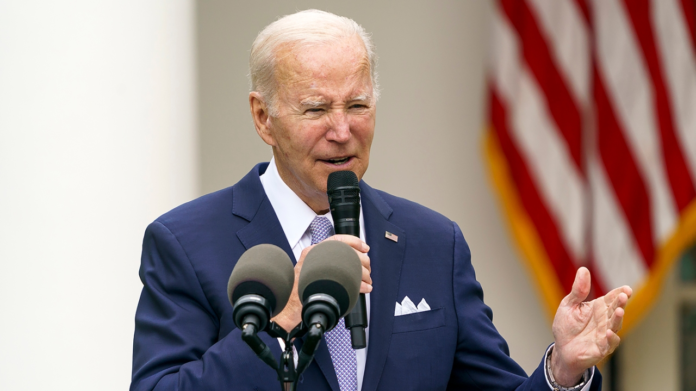The issue of student loans stands to loom over President Biden’s 2024 bid as he tackles one of his key first-term campaign promises being tied up at the Supreme Court.
Biden managed to deliver on the promise of developing a program to forgive a chunk of student debt to the cheers of many Democrats and progressives who pushed him on the issue during his first two years in the White House.
But his plan quickly hit a roadblock when GOP attorneys general sued the administration over the issue, which Republicans say would be “paid for” by people who never even attended college.
The White House had warned that such legal challenges would arise, but Biden went through with the program anyway.
The case made its way all the way up to the Supreme Court, where a conservative majority appears unlikely to give it the green light.
Now, Biden has to sell his accomplishment — but also its stoppage — on the 2024 campaign trail.
“The strategy should be to lay the blame for this stall on Republicans and their opposition. Biden did everything within his power to make good on his promise, and while this is a setback, he remains committed to finishing the job,” said Debra Dixon, former chief of staff at the Office of Planning, Evaluation and Policy Development at the Department of Education under President Obama.
“If the Supreme Court finds that student loan forgiveness was not within his administrative powers, then he will have to redouble his efforts to push for a legislative fix in a second term,” added Dixon, now a principal at Ferox Strategies.
Republicans have not shied away from their criticism of the debt forgiveness, messaging on how the plan is unfair to those who did not go to college or made huge sacrifices in order to avoid student loan debt.
South Carolina Sen. Tim Scott (R), who is likely running for president in 2024, said when Biden announced student loan relief last August that it was a “handout to the wealthy. Period.”
The administration is also likely to tout other measures they are attempting to put in place to make paying back student loans easier, such as reforms to income-driven repayments that could leave some borrowers paying zero dollars a month.
Meanwhile, it has attempted to show confidence in the legality of the current plan, refusing to talk about alternatives if the Supreme Court strikes it down.
But Biden in March slightly detracted from that strategy. He said that he’s “confident we’re on the right side of the law” but “not confident about the outcome of the decision yet,” while not offering any kind of Plan B.
Advocates are looking for the president to step up and do more through executive action if the Supreme Court does in fact strike down the plan.
“With the continued threat to the legitimacy of the Supreme Court, I do think borrowers are looking to say, ‘OK, should the Supreme Court come down with some unfavorable ruling, you still need to figure something out, you still need to cancel student debt some other way,’” said Braxton Brewington, spokesperson at the Debt Collective. “It’s not going to be enough to shrug your shoulders, take your ball, go home, and say, ‘I tried but the Supreme Court told me no.’”
Young people, many of whom struggle with student loan payments, are particularly essential to Biden’s reelection and have been left disappointed and confused with his promise of debt forgiveness that hasn’t yet been delivered.
The youth vote was key to Democratic victories in recent midterm and presidential elections, especially in this past November’s House and Senate contests.
“Young people are getting more involved in the issue of student loan debt than ever before. In the past, what we found was that current students, recent graduates and young people generally, they hadn’t really felt the burden of student debt in the way that maybe older borrowers did,” said Cody Hounanian, executive director of Student Debt Crisis Center.
“That has completely turned, a 180-degree turn. Young people, they see that student debt is an economic crisis that is preventing our entire economy from thriving and they see the writing on the wall that their futures are at risk because of the student debt crisis,” he said.
Biden is also going to face increasing calls to continue to extend the pandemic-related student loan pause as the perception of being the president who turns on a financial burden for voters during economic uncertainty could be a political killer.
The pause has been in place since former President Trump started it in 2020 and has been extended several times.
“Anybody that takes the pause off is going to be relatively unpopular for a while and not just with Democrats,” Daniel Collier, assistant professor of higher and adult education in the Department of Leadership at the University of Memphis, told The Hill in a recent interview.
Currently, Biden has repayments set to begin 60 days after the Supreme Court makes a decision on his debt relief proposal or 60 days after June 30, whichever comes first.
Whether Biden’s plan is declared legal or not, this is not the last the president will hear on the issue.
Liberals and progressives united around Biden’s up to $20,000 in relief, but top Democrats before his announcement were pushing for more.
Senate Majority Leader Charles Schumer (D-N.Y.) and Sen Elizabeth Warren (D-Mass.) back in 2021 were calling for Biden to forgive around $50,000 in student loan debt.
“An ocean of student loan debt is holding back 43 million borrowers and disproportionately weighing down Black and Brown Americans. Canceling $50,000 in federal student loan debt will help close the racial wealth gap, benefit the 40% of borrowers who do not have a college degree, and help stimulate the economy. It’s time to act. We will keep fighting,” Warren and Schumer said at the time.
Future of student loan forgiveness looms over Biden in 2024
RELATED ARTICLES




